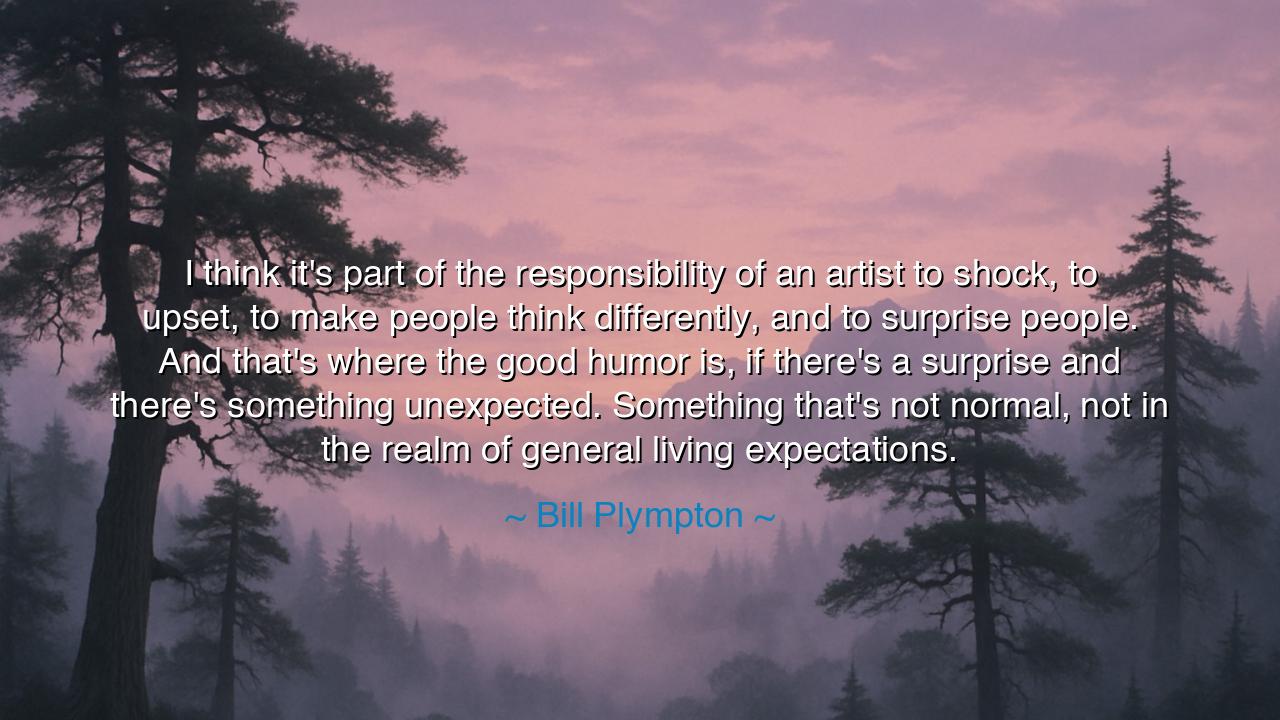
I think it's part of the responsibility of an artist to shock, to
I think it's part of the responsibility of an artist to shock, to upset, to make people think differently, and to surprise people. And that's where the good humor is, if there's a surprise and there's something unexpected. Something that's not normal, not in the realm of general living expectations.






“I think it’s part of the responsibility of an artist to shock, to upset, to make people think differently, and to surprise people. And that’s where the good humor is — if there’s a surprise, and there’s something unexpected, something that’s not normal, not in the realm of general living expectations.” — thus spoke Bill Plympton, the artist of imagination and rebellion, whose hand drew not what was safe, but what was true. His words are a hymn to the sacred duty of creation — to disturb complacency, awaken thought, and reveal the extraordinary that hides beneath the ordinary. For art, in its purest form, is not decoration; it is revelation.
The responsibility of the artist, as Plympton declares, is not to comfort the world, but to awaken it. To shock is not to offend for sport, but to shatter illusion, to tear through the veil of habit that dulls human perception. When the spirit of art grows tame, it dies. True art is fire — unpredictable, consuming, radiant — it burns away the familiar so that the soul may see anew. Thus, the artist becomes both creator and provoker, the one who breaks so that truth may emerge.
In ancient times, the poets and prophets carried this same burden. When Socrates walked through Athens, questioning the wise, he shocked his fellow citizens not with mockery, but with truths that unsettled the mind. They called him dangerous because he dared to ask, “Why do you believe what you believe?” And yet, through that disturbance, Greece found philosophy — the art of thinking deeply. Plympton’s words echo that same lineage: that the role of the artist is to stir the still waters of the soul, to make people think differently, and in doing so, to remind them that they are alive.
The mention of good humor is no accident. For humor, when it is great, is the sister of wisdom. It thrives on surprise, on that sudden bending of expectation that forces both laughter and thought. The jest that offends but enlightens, the irony that exposes truth through absurdity — these are tools as ancient as the jester’s mask and as powerful as the philosopher’s pen. When Plympton speaks of humor born from the unexpected, he reveals its noblest purpose: not to amuse, but to awaken joy and awareness together.
There is a story told of Diogenes, the Cynic philosopher, who once wandered the marketplace of Athens holding a lantern in broad daylight. When asked what he was doing, he replied, “I am looking for an honest man.” The people laughed — but beneath that laughter, they felt the sting of recognition. Diogenes shocked them into seeing their own hypocrisy. This is the essence of Plympton’s teaching: that the artist’s tools — whether pen, paint, or performance — are not weapons of destruction, but instruments of awakening.
The origin of this truth lies deep within the nature of the human mind. People live wrapped in routine, enclosed within the narrow walls of what they call “normal.” Yet, the unexpected is the door through which imagination enters. Without it, there is no progress, no growth, no wonder. The artist, therefore, is the keeper of that door — the one who dares to open it and invite the world to look beyond. To surprise is not to rebel against life, but to remind life of its infinite possibilities.
And so, O seeker of beauty and meaning, take this as your lesson: do not fear to shock, to question, to create differently. Whether your art is painting or speech, music or thought, let it never bow to comfort or conformity. Let it burn, startle, and illuminate. Seek humor that enlightens, not flatters; seek creativity that frees, not repeats. For the artist’s duty is not to soothe the sleeping, but to awaken the dreamers who have forgotten they are dreaming.
In the end, Bill Plympton reminds us that art is a living force — divine, restless, and eternal. It thrives wherever courage meets curiosity. So go forth, creator of tomorrow: dare to be unexpected, dare to disturb the dull peace of ordinary thinking. For in that daring lies the laughter of truth, the spark of renewal, and the echo of the eternal — the voice of art itself, calling mankind to awaken once more.






AAdministratorAdministrator
Welcome, honored guests. Please leave a comment, we will respond soon